
Actinopterygii, members of which are known as ray-finned fish or actinopterygians, is a class of bony fish that comprise over 50% of living vertebrate species. They are so called because of their lightly built fins made of webbings of skin supported by radially extended thin bony spines called lepidotrichia, as opposed to the bulkier, fleshy lobed fins of the sister class Sarcopterygii. Resembling folding fans, the actinopterygian fins can easily change shape and wetted area, providing superior thrust-to-weight ratios per movement compared to sarcopterygian and chondrichthyian fins. The fin rays attach directly to the proximal or basal skeletal elements, the radials, which represent the articulation between these fins and the internal skeleton.

The Jurassic is a geologic period and stratigraphic system that spanned from the end of the Triassic Period 201.4 million years ago (Mya) to the beginning of the Cretaceous Period, approximately 145 Mya. The Jurassic constitutes the middle period of the Mesozoic Era and is named after the Jura Mountains, where limestone strata from the period were first identified.

Gars are an ancient group of ray-finned fish in the family Lepisosteidae. They comprise seven living species of fish in two genera that inhabit fresh, brackish, and occasionally marine waters of eastern North America, Central America and Cuba in the Caribbean, though extinct members of the family were more widespread. They are the only surviving members of the Ginglymodi, a clade of fish which first appeared during the Triassic, over 240 million years ago, and are one of only two surviving groups of holosteian fish, alongside the bowfins, which have a similar distribution.

Elasmobranchii is a subclass of Chondrichthyes or cartilaginous fish, including modern sharks, rays, skates, and sawfish. Members of this subclass are characterised by having five to seven pairs of gill clefts opening individually to the exterior, rigid dorsal fins and small placoid scales on the skin. The teeth are in several series; the upper jaw is not fused to the cranium, and the lower jaw is articulated with the upper. The details of this jaw anatomy vary between species, and help distinguish the different elasmobranch clades. The pelvic fins in males are modified to create claspers for the transfer of sperm. There is no swim bladder; instead, these fish maintain buoyancy with large livers rich in oil.

The South Polar region of the Cretaceous comprised the continent of East Gondwana–modern day Australia, Zealandia, and Antarctica–a product of the break-up of Gondwana in the Cretaceous Period. The southern region, during this time, was much warmer than it is today, ranging from perhaps 4–8 °C (39–46 °F) in the latest Cretaceous Maastrichtian in what is now southeastern Australia. This prevented permanent ice sheets from developing and fostered polar forests, which were largely dominated by conifers, cycads, and ferns, and relied on a temperate climate and heavy rainfall. Major fossil-bearing geological formations that record this area are: the Santa Marta and Sobral Formations of Seymour Island off the Antarctic Peninsula; the Snow Hill Island, Lopez de Bertodano, and the Hidden Lake Formations on James Ross Island also off the Antarctic Peninsula; and the Eumeralla and Wonthaggi Formations in Australia.

Torvosaurus is a genus of large megalosaurine theropod dinosaur that lived approximately 165 to 148 million years ago during the Callovian to Tithonian ages of the late Middle and Late Jurassic period in what is now Colorado, Portugal, Germany, and possibly England, Spain, Tanzania, and Uruguay. It contains two currently recognized species, Torvosaurus tanneri and Torvosaurus gurneyi, plus a third unnamed species from Germany.
Acipenser is a genus of sturgeons. With 17 living species, it is the largest genus in the order Acipenseriformes. The genus is paraphyletic, containing all sturgeons that do not belong to Huso, Scaphirhynchus, or Pseudoscaphirhynchus, with many species more closely related to the other three genera than they are to other species of Acipenser. They are native to freshwater and estuarine systems of Eurasia and North America, and most species are threatened. Several species also known to enter near-shore marine environments in the Atlantic, Arctic and Pacific oceans.
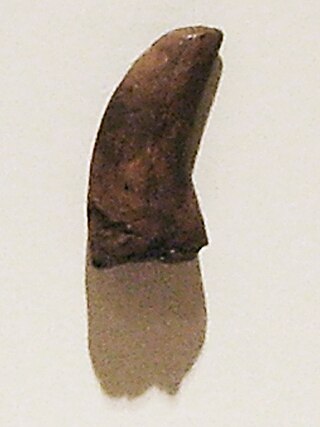
Dromaeosauroides is a genus of dromaeosaurid theropod dinosaur from the Early Cretaceous of what is now Denmark and possibly also England. It was discovered in the Jydegaard Formation in the Robbedale valley, on the island of Bornholm in the Baltic Sea. This is the only likely place for dinosaur remains to be discovered on Danish territory, since the Mesozoic deposits exposed in the rest of the country are marine. Dromaeosauroides is the first known dinosaur from Denmark, and the only one which has been scientifically named. It is one of the oldest known dromaeosaurs in the world, and the first known uncontested dromaeosaur from the Early Cretaceous of Europe.
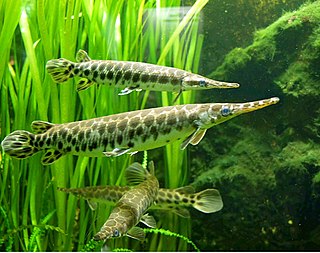
Lepisosteiformes is an order of ray-finned fish and the only living members of the clade Ginglymodi. Its only extant representatives are the gar, and it is defined as all members of Ginglymodi that are more closely related to gar than to the extinct Semionotiformes, the other major grouping of ginglymodians. They are one of two extant orders in the infraclass Holostei alongside the Amiiformes.

Saurichthys is an extinct genus of predatory ray-finned fish from the Triassic Period. It is the type genus of the family Saurichthyidae, and the most speciose and longest lasting genus in the family. This family also includes the Permian Eosaurichthys (China) and the Jurassic Saurorhynchus from Europe and North America, though it may be more appropriate to treat these as subgenera of Saurichthys, due to the genus Saurichthys otherwise being paraphyletic.
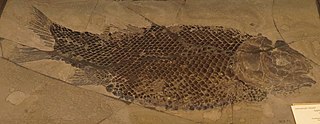
Lepidotes is an extinct genus of Mesozoic ray-finned fish. It has long been considered a wastebasket taxon, characterised by "general features, such as thick rhomboid scales and, for most of the species, by semi-tritorial or strongly tritorial dentition". with dozens of species assigned to it. Fossils attributed to Lepidotes have been found in Jurassic and Cretaceous rocks worldwide. It has been argued that Lepidotes should be restricted to species closely related to the type species L. gigas, which are only known from the Early Jurassic of Western and Central Europe, with most other species being not closely related, with other species transferred to new genera such as Scheenstia.Lepidotes belongs to Ginglymodi, a clade of fish whose only living representatives are the gars (Lepisosteidae). The type species L. gigas and close relatives are thought to be members of the family Lepidotidae, part of the order Lepisosteiformes within Ginglymodi, with other species occupying various other positions within Ginglymodi.
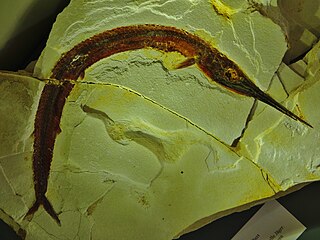
Belonostomus is a genus of prehistoric ray-finned fish that was described by Louis Agassiz in 1844. It is a member of the order Aspidorhynchiformes, a group of fish known for their distinctive elongated rostrums.

Hybodontiformes, commonly called hybodonts, are an extinct group of shark-like cartilaginous fish (chondrichthyans) which existed from the late Devonian to the Late Cretaceous. Hybodonts share a close common ancestry with modern sharks and rays (Neoselachii) as part of the clade Euselachii. They are distinguished from other chondrichthyans by their distinctive fin spines and cephalic spines present on the heads of males. An ecologically diverse group, they were abundant in marine and freshwater environments during the late Paleozoic and early Mesozoic, but were rare in open marine environments by the end of the Jurassic, having been largely replaced by modern sharks, though they were still common in freshwater and marginal marine habitats. They survived until the end of the Cretaceous, before going extinct.

Pachycostasaurus is an extinct Pliosauroid from the Oxford Clay formation of Peterborough, England.

Scheenstia is an extinct genus of neopterygian ray-finned fish from the Late Jurassic–Early Cretaceous of Europe. Fossils have been found in both marine and freshwater environments.
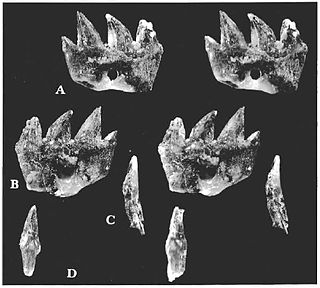
Ichthyoconodon is an extinct genus of eutriconodont mammal from the Lower Cretaceous of Morocco. It is notable for having been found in a unique marine location, and the shape of its teeth suggests an unusual, potentially fish-eating ecological niche. Analysis suggests it is part of a group of gliding mammals that includes Volaticotherium.

Ceratodontiformes is the only extant order of lungfish, containing the families Neoceratodontidae, Lepidosirenidae, and Protopteridae as well as many other extinct groups. Members of this group are the only lungfish known to have survived the Permian-Triassic extinction event. Although lungfish originated in marine environments, the Ceratodontiformes have been an exclusively freshwater group since the Carboniferous. This order was formerly considered the suborder Ceratodontoidei.

Ginglymodi is a clade of ray-finned fish containing modern-day gars (Lepisosteidae) & their extinct relatives in the order Lepisosteiformes, the extinct orders Semionotiformes and Kyphosichthyiformes, and various other extinct taxa. Ginglymodi is one of the two major subgroups of the infraclass Holostei, the other one being Halecomorphi, which contains the bowfin and eyespot bowfin and their fossil relatives.

Lepidotidae is an extinct family of fish, known from the Jurassic and Cretaceous periods. Most species were originally assigned to the genus Lepidotes which was long considered a wastebasket taxon. Cladistic analysis has indicated that they are close relatives of gars, with both being members of the order Lepisosteiformes. Members of the family are known from both marine and freshwater environments. Their bulky body morphology and small median fins suggests that they were slow-moving fish that were capable of performing fine movements in order to grasp prey. Lepidotes sensu stricto had peg-like grasping marginal teeth and crushing palatal teeth, and is known to have consumed small crustaceans, while Scheenstia had low rounded crushing marginal teeth, indicating a durophagous diet.

Atractosteus grandei is an extinct species of gar in the family Lepisosteidae. Remains have been found in Lower Paleogene sediments from North Dakota. A. grandei belonged to the genus Atractosteus which includes modern day species of gars such as the giant alligator gar and the tropical gar. It is named after paleontologist and ichthyologist Lance Grande.



















